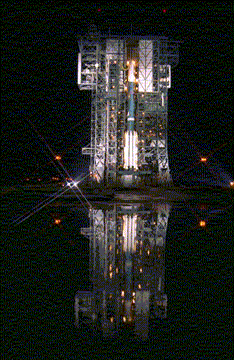PropulsionHow do conventional rockets work? |

Photo Credit: NASA.From the John F. Kennedy Space Center Photo Archives at
http://www-pao.ksc.nasa.gov/kscpao/captions/1997/aug/97pc1287.htm
The Delta II rocket is a chemical rocket designed to have enough thrust to lift its payload out of Earth's gravity well and into orbit. A launch vehicle has to go fast enough to get to Earth's escape velocity. Like many launch rockets made for this purpose, the Delta II is a kind of rocket called a multi-stage rocket. That means that it is made of several components, called stages, all stacked onto each other. Each stage is a rocket with its own propellant.
The reason for a multi-stage rocket is as follows. The larger the rocket, the more thrust it can provide. However large rockets are also massive, which means they are heavy. This makes them harder to lift away from gravity. A multi-stage rocket allows for a lot of thrust power, but as a part of the fuel is used, the fuel tank containing the fuel can be dropped, lightening the rocket.
![]()
How did DS1 get into space?
How are rockets designed?
What is a propellant?
How does propulsion work?
What is gravity?
![]()
What is thrust?
What is chemical propulsion?
Why is mass important?
Why does it take so much energy to launch DS1?
What is escape velocity?
![]()
![]()